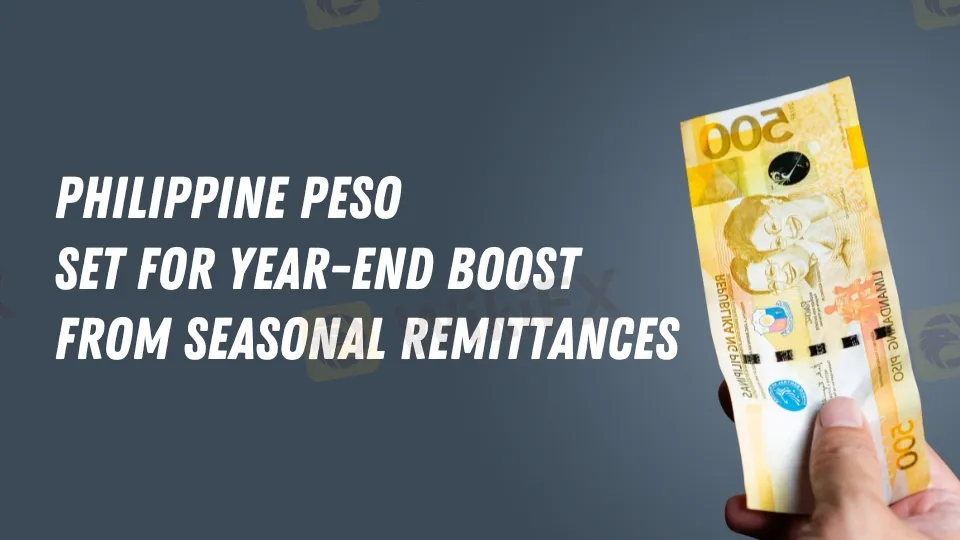简体中文
繁體中文
English
Pусский
日本語
ภาษาไทย
Tiếng Việt
Bahasa Indonesia
Español
हिन्दी
Filippiiniläinen
Français
Deutsch
Português
Türkçe
한국어
العربية
Philippine Peso Set for Year-End Boost from Seasonal Remittances
Abstract:The Philippine peso anticipates a year-end recovery driven by strong remittances, lower oil prices, and easing dollar strength amid the holiday season.

The Philippine peso, which has been under pressure since October, is likely to recover before the end of the year, owing to a seasonal rise in overseas Filipino worker (OFW) remittances. As Christmas approaches, these remittances normally increase, bolstering the value of the peso. This tendency has occurred in six of the previous seven years, and experts predict a similar conclusion in 2024.
According to the Australia and New Zealand Banking Group (ANZ), the peso might rise by more than 5% by the end of the year. The euro has fallen almost 4% this quarter, but experts believe it will reverse. According to Michael Ricafort, chief economist of Rizal Commercial Banking Corp., the peso will rise by around 4% by December. He observes that this seasonal stream of remittances, together with lower world oil prices, provide natural support for the peso.

Remittances reached $33.5 billion in 2023, making it one of the Philippines' most important foreign currency sources. These inflows provide a significant buffer for the peso and may offset the current decline that has driven the currency approaching a record low versus the US dollar.
Furthermore, any rate reduction by the US Federal Reserve may help the peso.
The Philippines is strongly reliant on fuel imports, therefore the drop in world oil prices is especially important. Lower oil prices aid in the reduction of the country's trade imbalance, relieving pressure on the local currency. The peso rose 0.8% this week, trading at 58.26 versus the US dollar.
However, others are concerned about the dollar's potential strength in the face of shifting US policy. Furthermore, future remittances from the United States may be influenced by changes in immigration rules. Nonetheless, experts observe that the Philippines' lower inflation rates and positive balance of payments provide a favorable environment for the peso's rise until the end of the year.
Khoon Goh, director of Asia research at ANZ, believes the peso will rise to 55.5 per dollar by December.
Final Thoughts
As the Christmas season approaches, the Philippine peso is expected to benefit from increased remittances and reduced oil costs. While certain dangers remain, a healthy balance of payments and low inflation indicate that the peso is on pace for a year-end rebound, offering hope for the Philippine economy in the face of global uncertainty.

Disclaimer:
The views in this article only represent the author's personal views, and do not constitute investment advice on this platform. This platform does not guarantee the accuracy, completeness and timeliness of the information in the article, and will not be liable for any loss caused by the use of or reliance on the information in the article.
Read more

Webull Launches SMSF Investment Platform with Zero Fees
Webull introduces commission-free SMSF trading, offering over 3,500 US and Australian ETFs, with no brokerage fees and enhanced portfolio tools.

Australian Authorities Joins Forces with Philippine Authorities to Combat Cyber Scams
AFP tackles cyber scam boiler rooms in the Philippines, training police to fight fraud and protect Australians from romance and cryptocurrency scams.

How Will the Market React at a Crucial Turning Point?
Safe-haven assets like gold and U.S. Treasuries are surging, while equities face mounting pressure. As this pivotal moment approaches, how will the market react?

Gold Prices Climb Again – Have Investors Seized the Opportunity?
Gold prices have hit record highs for three consecutive days, with a remarkable 19% gain in the first quarter, marking the strongest quarterly performance since 1986. As market risk aversion rises, demand for gold has surged significantly.
WikiFX Broker
Latest News
Exposing the Top 5 Scam Brokers of March 2025: A Closer Look by WikiFX
Gold Prices Climb Again – Have Investors Seized the Opportunity?
Webull Launches SMSF Investment Platform with Zero Fees
Australian Regulator Warns of Money Laundering and Fraud Risks in Crypto ATMs
FCA Warns Against 10 Unlicensed or Clone Firms
CySEC Warns Against 14 Unlicensed Investment Websites
Top Currency Pairs to Watch for Profit This Week - March 31, 2025
Will natural disasters have an impact on the forex market?
Philippines Deports 29 Indonesians Linked to Online Scam Syndicate in Manila
AI-Powered Strategies to Improve Profits in Forex Trading
Currency Calculator







